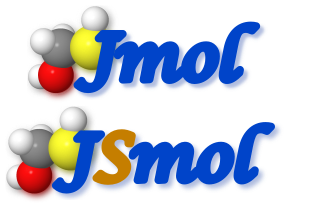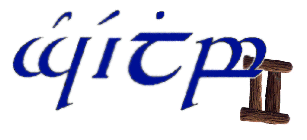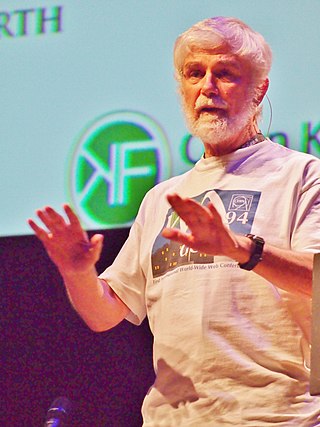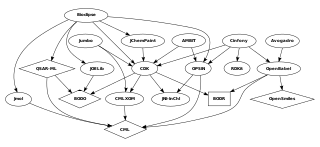Related Research Articles

Extensible Markup Language (XML) is a markup language and file format for storing, transmitting, and reconstructing arbitrary data. It defines a set of rules for encoding documents in a format that is both human-readable and machine-readable. The World Wide Web Consortium's XML 1.0 Specification of 1998 and several other related specifications—all of them free open standards—define XML.
Cheminformatics refers to the use of physical chemistry theory with computer and information science techniques—so called "in silico" techniques—in application to a range of descriptive and prescriptive problems in the field of chemistry, including in its applications to biology and related molecular fields. Such in silico techniques are used, for example, by pharmaceutical companies and in academic settings to aid and inform the process of drug discovery, for instance in the design of well-defined combinatorial libraries of synthetic compounds, or to assist in structure-based drug design. The methods can also be used in chemical and allied industries, and such fields as environmental science and pharmacology, where chemical processes are involved or studied.
A chemical file format is a type of data file which is used specifically for depicting molecular data. One of the most widely used is the chemical table file format, which is similar to Structure Data Format (SDF) files. They are text files that represent multiple chemical structure records and associated data fields. The XYZ file format is a simple format that usually gives the number of atoms in the first line, a comment on the second, followed by a number of lines with atomic symbols and cartesian coordinates. The Protein Data Bank Format is commonly used for proteins but is also used for other types of molecules. There are many other types which are detailed below. Various software systems are available to convert from one format to another.
Open Babel is computer software, a chemical expert system mainly used to interconvert chemical file formats.
The World Wide Molecular Matrix (WWMM) was a proposed electronic repository for unpublished chemical data. First introduced in 2002 by Peter Murray-Rust and his colleagues in the chemistry department at the University of Cambridge in the United Kingdom, WWMM provided a free, easily searchable database for information about thousands of complicated molecules, data that would otherwise remain inaccessible to scientists.

Jmol is computer software for molecular modelling chemical structures in 3-dimensions. Jmol returns a 3D representation of a molecule that may be used as a teaching tool, or for research e.g., in chemistry and biochemistry.

JOELib is computer software, a chemical expert system used mainly to interconvert chemical file formats. Because of its strong relationship to informatics, this program belongs more to the category cheminformatics than to molecular modelling. It is available for Windows, Unix and other operating systems supporting the programming language Java. It is free and open-source software distributed under the GNU General Public License (GPL) 2.0.

The Chemistry Development Kit (CDK) is computer software, a library in the programming language Java, for chemoinformatics and bioinformatics. It is available for Windows, Linux, Unix, and macOS. It is free and open-source software distributed under the GNU Lesser General Public License (LGPL) 2.0.
This page describes mining for molecules. Since molecules may be represented by molecular graphs this is strongly related to graph mining and structured data mining. The main problem is how to represent molecules while discriminating the data instances. One way to do this is chemical similarity metrics, which has a long tradition in the field of cheminformatics.

Henry Stephen Rzepa is a chemist and Emeritus Professor of Computational Chemistry at Imperial College London.

Peter Murray-Rust is a chemist currently working at the University of Cambridge. As well as his work in chemistry, Murray-Rust is also known for his support of open access and open data.

ChemDraw is a molecule editor first developed in 1985 by Selena "Sally" Evans, her husband David A. Evans, and Stewart Rubenstein. The company was sold to PerkinElmer in the year 2011. ChemDraw, along with Chem3D and ChemFinder, is part of the ChemOffice suite of programs and is available for Macintosh and Microsoft Windows.
Wiswesser line notation (WLN), invented by William J. Wiswesser in 1949, was the first line notation capable of precisely describing complex molecules. It was the basis of ICI Ltd's CROSSBOW database system developed in the late 1960s. WLN allowed for indexing the Chemical Structure Index (CSI) at the Institute for Scientific Information (ISI). It was also the tool used to develop the CAOCI (Commercially Available Organic Chemical Intermediates) database, the datafile from which Accelrys' (successor to MDL) ACD file was developed. WLN is still being extensively used by BARK Information Services. Descriptions of how to encode molecules as WLN have been published in several books.
ChemSpider is a freely accessible online database of chemicals owned by the Royal Society of Chemistry. It contains information on more than 100 million molecules from over 270 data sources, each of them receiving a unique identifier called ChemSpider Identifier.

Blue Obelisk is an informal group of chemists who promote open data, open source, and open standards; it was initiated by Peter Murray-Rust and others in 2005. Multiple open source cheminformatics projects associate themselves with the Blue Obelisk, among which, in alphabetical order, Avogadro, Bioclipse, cclib, Chemistry Development Kit, GaussSum, JChemPaint, JOELib, Kalzium, Openbabel, OpenSMILES, and UsefulChem.
Louis Hodes was an American mathematician, computer scientist, and cancer researcher.

Christoph Steinbeck is a German chemist and has a professorship for analytical chemistry, cheminformatics and chemometrics at the Friedrich-Schiller-Universität Jena in Thuringia.
ChemWindow is a chemical structure drawing molecule editor and publishing program now published by John Wiley & Sons as of 2020, originally developed by Bio-Rad Laboratories, Inc. It was first developed by SoftShell International in the 1990s. Bio-Rad acquired this technology in 1996 and eventually made it part of their KnowItAll software product line, offering a specific ChemWindow edition of their software for structure drawing and publishing. They have also incorporated ChemWindow structure drawing components into their KnowItAll spectroscopy software packages with their DrawIt, ReportIt, and MineIt tools.
References
- ↑ Murray-Rust, Peter; Rzepa, Henry S (2011). "CML: Evolution and design". Journal of Cheminformatics . 3 (1): 44. doi: 10.1186/1758-2946-3-44 . PMC 3205047 . PMID 21999549.
- ↑ Murray-Rust, P.; Rzepa, H. S. (1999), "Chemical Markup, XML, and the Worldwide Web. 1. Basic Principles", J. Chem. Inf. Comput. Sci. , 39 (6): 928–942, CiteSeerX 10.1.1.40.8275 , doi:10.1021/ci990052b
- ↑ Murray-Rust, P.; Rzepa, H. S. (2003), "Chemical Markup, XML and the World Wide Web. 4. CML Schema", J. Chem. Inf. Comput. Sci. , 43 (3): 757–772, doi:10.1021/ci0256541, PMID 12767134
- ↑ Gkoutos, G. V.; Murray-Rust, P.; Rzepa, S.; Wright, M. (2001), "Chemical Markup, XML, and the World-Wide Web. 3. Toward a Signed Semantic Chemical Web of Trust", J. Chem. Inf. Comput. Sci. , 41 (5): 1124–1130, doi:10.1021/ci000406v, PMID 11604013
- ↑ Holliday, G. L.; Murray-Rust, P.; Rzepa, H. S. (2006), "Chemical Markup, XML and the World Wide Web. Part 6. CMLReact; An XML Vocabulary for Chemical Reactions", J. Chem. Inf. Model. , 46 (1): 145–157, doi:10.1021/ci0502698, PMID 16426051
- ↑ Kuhn, S.; Helmus, T.; Lancashire, R. J.; Murray-Rust, P.; Rzepa, H. S.; Steinbeck, C.; Willighagen, E. L. (2007), "Chemical Markup, XML, and the World Wide Web. 7. CMLSpect, an XML Vocabulary for Spectral Data", J. Chem. Inf. Model. , 47 (6): 2015–2034, doi:10.1021/ci600531a, PMID 17887743
- ↑ JUMBO
- ↑ Murray-Rust, P.; Rzepa, H. S. (2001), "Chemical Markup, XML and the World-Wide Web. 2. Information Objects and the CMLDOM", J. Chem. Inf. Comput. Sci. , 41 (5): 1113–1123, doi:10.1021/ci000404a, PMID 11604012
- ↑ CML home on Sourceforge
- ↑ Willighagen, E.L. (2001). "Processing CML Conventions in Java". Internet Journal of Chemistry. 4. Archived from the original on 2001-04-11.